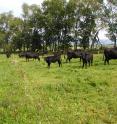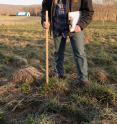More for less in pastures
Getting more for less is an attractive concept. But it isn't that easy when it comes to producing more food on less land with fewer resources. R. Howard Skinner has been researching this idea of more for less in agriculture. Skinner is a physiological plant ecologist and member of the USDA-ARS-Pasture Systems and Watershed Management Research Unit. He's been looking into how to increase the amount of forage (grasses and plants that animals eat) pastures can grow. If a piece of land can produce more forage, it can feed more cows. More cows mean more beef and milk.
Previous studies suggest incorporating multiple types of plants in pastures is an effective way to increase the amount of forage. However, these studies varied in length. It hasn't been possible to say for sure what long-term effect using multiple types of plants has on forage production. To learn more, Skinner spent nine years tracking the progress of multispecies pastures.
Skinner and his team at Pennsylvania State University Hawbecker Farm planted eight experimental paddocks. They planted four paddocks with orchard grass and white clover. Another four paddocks had a combination of chicory, orchardgrass, tall fescue, white clover, and alfalfa. When the plants reached a certain height, cows grazed in the paddocks.
The researchers collected samples of the forage before and after the cows grazed. This helped them estimate the amount of forage produced and determine what types of plants were present in the paddocks. Additionally, researchers collected soil samples to check on the plant roots and determine how much carbon was being stored in the soil.
Skinner tracked changes in the amounts of each plant species over the course of the nine years. "We expected some of the species from the more complex mixture to disappear over time," he explains. What he didn't expect was the continued superior performance of the five-species mixture even after some of the species disappeared. "Initially I would have thought the loss of species from the more complex mixture was a negative, but this research suggests that by improving soil conditions, specifically soil organic matter, the initial inclusion of multiple species had a long-lasting positive effect even after species differences had disappeared."
The five-species mixture produced, on average over the nine years, 31% more forage than the two-species mixture. This could be because the five-species mixtures were also storing more carbon in the soil than the two-species mixtures.
These results are encouraging, and reach beyond mere number of forage plants. Increased forage production means more beef and milk. And increased amounts of carbon stored in the soil also means the soil can hold more water.
"The greatest challenge from climate change in the northeast probably has more to do with water availability (both too much and too little) than heat," says Skinner. Incorporating multiple species into pastures may be able to help protect against runoff after heavy storms and against droughts during dry years.
Overall, this nine-year study supports previous findings that multispecies pastures can produce more forage, but there are still many more decade-long studies that need to be done. In the meantime, Skinner recommends researchers and land managers "select a few species with specific goals in mind," but understand that many factors, including how the land was previously managed, will have a bearing on results.
Skinner's research is published in Crop Science.
Source: American Society of Agronomy
Other sources
- More for less in pasturesfrom Science DailyWed, 20 Jul 2016, 19:21:14 UTC
- More for Less in Pasturesfrom Newswise - ScinewsWed, 20 Jul 2016, 18:41:11 UTC
- More for less in pastures: Multispecies pastures show productivity, drought tolerant promisefrom PhysorgWed, 20 Jul 2016, 18:21:27 UTC

